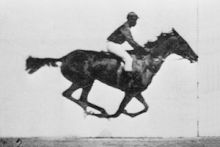Horses in art
In the United Kingdom, depictions of fox hunting and nostalgic rural scenes involving horses continue to be made.
Horses often appear in artworks singly, as a mount for an important person, or in teams, hitched to a variety of horse-drawn vehicles.
The Horses of Saint Mark are the sole surviving example from Classical Antiquity of a monumental statue of the Quadriga.
Painters of this period who portrayed the horse included Paolo Uccello, Benozzo Gozzoli, Leonardo da Vinci, Albrecht Dürer, Raphael, Andrea Mantegna, and Titian.
In the Baroque era, the tradition of equine portraiture was established, with artists such as Peter Paul Rubens, Anthony van Dyck and Diego Velázquez portraying regal subjects atop their mounts.
The mid-18th century saw the emergence of Romanticism, French artists Théodore Géricault and Eugène Delacroix were proponents of this movement and both portrayed the horse in many of their works.
[3] Eadweard Muybridge's photographic studies of animal motion had a huge influence on equine art, as they allowed artists greater understanding of the horses gaits.
In the medieval period, cavalry battles and knights on horseback were portrayed by artists including Paolo Uccello and Albrecht Dürer.
[11] Elizabeth Thompson, known as Lady Butler, was famed for her military art, especially Scotland Forever featuring a dramatic charge by the Royal Scots Greys.
In the 20th century, much of the artwork by John Skeaping involved the racing scene, including life-size bronzes of Hyperion and Brigadier Gerard and watercolours of racecourse action.
Remington was one of the first American artists to illustrate the true gait of the horse in motion (along with Thomas Eakins), as validated by the famous sequential photographs of Eadweard Muybridge.
[14] Remington also captured equine drama in his bronze sculptures, his first, Bronco Buster (Williams College Museum of Art), was a critical and commercial success.
Franz Marc and others including Susan Rothenberg and Deborah Butterfield beginning in the 1970s used horses as motifs in their paintings and sculpture throughout the 20th century.












